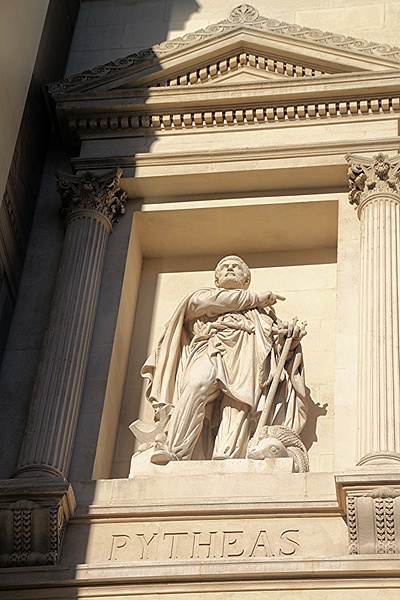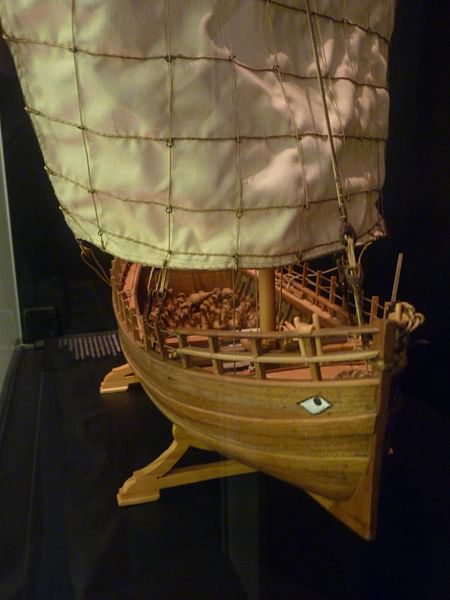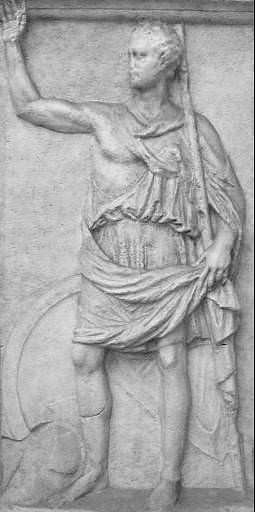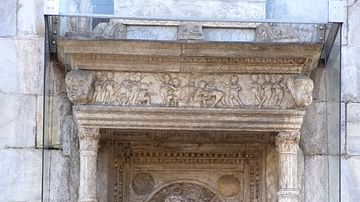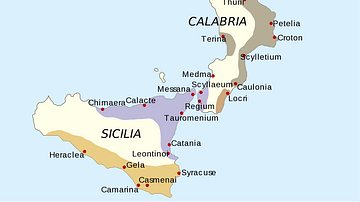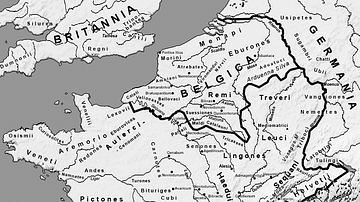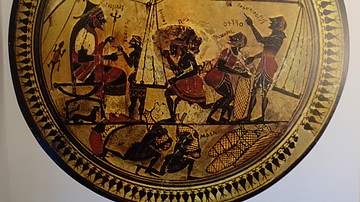Sometime around 330 BCE, Pytheas, a little-known Greek merchant, embarked on an astonishing voyage. It was a voyage that would take him far beyond the known boundaries of the Mediterranean, into lands thought to exist only in myth and legend. When he returned, his voyage and the amazing things he had witnessed would be debated for centuries.
Pytheas was a citizen of the western Greek city of Massilia (modern-day Marseille), which became a major trading power in the western Mediterranean as a result of its favorable location along the southern coast of Gaul (France). He was known as a skilled navigator, astronomer, and mariner. His account of the voyage, called On the Ocean (Peri tou Okeanou), documented a sea journey to Britain, the North Sea, and the coastline of northeastern Europe, the mysterious northern lands that were the sources of the Mediterranean's supply of tin, amber, and gold. Written in Greek sometime around 325 BCE, it is perhaps the earliest documented description of the British Isles and its inhabitants. Significantly, it also contains tantalizing evidence that Pytheas may have reached as far north as Iceland and the Arctic Ocean. These were lands that in Greek myths were occupied by a race of giants known as the Hyperboreans. Unfortunately, little details about the voyage exist as the treatise has not survived. Although it was well known in antiquity, only fragments of it have been preserved, excerpted or paraphrased in the writings of other classical writers.
Unlike many of the maritime-focused writings of the time, On the Ocean is not considered a periplus, or at the very least it is not considered a typical periplus. These were essentially maritime logs or navigation guides. They contained a host of practical information such as distances between prominent coastal landmarks or astronomical observations intended to aid in sea voyages. By contrast, On the Ocean, although it does cover such information, is nonetheless much grander and more ambitious in scale. It is a firsthand account of Pytheas's voyage and contains a multitude of astronomical, geographic, biological, oceanographic, and ethnological observations. In fact, many modern scholars consider it a document of considerable scientific and anthropological significance.
The Sources
The voyage of Pytheas has come down to us from several writers. Notably, these include Timaeus, Eratosthenes, Pliny the Elder, Diodorus Siculus, Strabo, and Polybius. These last two writers, however, were openly hostile to the very idea of such a voyage. The geographer Strabo (63 BCE - 24 CE), for example, claimed in his famous work Geography that Pytheas was 'the worst possible liar' and that the majority of his writings were mere 'fabrications ' (Roseman, 24). Despite this, Strabo is a major source for Pytheas; he quotes the Greek explorer on a number of occasions in Geography, though most of these are presented in such a manner so as to discredit Pytheas and cast doubt on the validity of his voyage.
Many scholars believe that Strabo's harsh accusations were derived from the work of Polybius (c. 200 BCE - c. 118 BCE), the 2nd-century Greek historian who was even more vociferous in his denunciations of Pytheas. Book 34 of Polybius' The Histories, which only survives in fragments, is an extended polemic against Pytheas. The animosity directed at Pytheas from these two writers is curious and may, in fact, have stemmed from nothing more complicated than what British archaeologist Barry Cunliffe has called 'professional jealousy' (Cunliffe, 173).
Other classical writers, by contrast, were entirely well-disposed toward Pytheas and accepted On the Ocean as a valid account. Foremost among these was the historian Timaeus (c. 345 BCE - c. 250 BCE), who wrote a lengthy treatise on the history of Sicily and the western Mediterranean. He very likely had a copy of On the Ocean and quoted from it on numerous occasions in his own work. The famous geographer and chief librarian at Alexandria Eratosthenes of Cyrene (c. 276 BCE - 194 BCE) also referenced Pytheas in a treatise that, like On the Ocean, has been lost but that was widely circulated in the ancient world.
Many scholars believe that the Roman historian and writer Pliny (23 CE - 79 CE) received much of his information about Pytheas from Timaeus. Like Timaeus, he quotes from On the Ocean a number of times in his work Natural History, frequently prefacing his statements with the phrase, "According to Pytheas…" or "Pytheas of Massalia wrote…" The Greek historian Diodorus Siculus (c. 90 BCE – 30 BCE), who wrote his monumental Bibliotheca Historica around the time of Augustus, was also known to have borrowed heavily from the writings of Timaeus, especially his discussion of ancient Britain.
The Voyage
Based on these (and other) scattered fragments, modern scholars have attempted to piece together aspects of the voyage, though many details remain speculative. For example, the kind of vessel Pytheas may have used has never been determined with any degree of certainty. In fact, a number of historians - Cunliffe among them - have suggested he traveled mostly on foot and may have used Celtic currach-style boats for water crossings. But it is also possible that Pytheas, if indeed he was a merchant, may have sailed on a holkas. These were Greek cargo ships, sturdy, well-made vessels with large drafts, designed primarily for hauling merchandise. Generally flat-bottomed, round-hulled, and propelled primarily by sails, these were very different from the sleeker, more well-known triremes, the Greek warships.
Equally speculative is his precise route. However, it is generally accepted that Pytheas began his voyage from Massalia and sailed west through the Pillars of Hercules (the modern Straits of Gibraltar). He pushed out into the Atlantic, cruising north along the western coasts of Spain and France and possibly made landfall on Brittany. From there, he crossed the English Channel to a spot he called 'Belerion,' which modern scholars believe to be Cornwall. It was here he witnessed the British inhabitants mining tin for trade to Gaul and thence to the Mediterranean. Pliny, quoting Timaeus, writes: "there is an island called Mictis lying six days sail inwards from Britannia where tin is to be found. The Britons cross to the island in wicker boats sewn over with hides" (Cunliffe, 75). The precise location of this island is unknown but has been variously proposed as St. Michaels' Mount in Cornwall, the Mount Batten peninsula in Devon, or the Isle of Wight.
Diodorus Siculus called the island of Britain 'Pretannia' and its inhabitants the 'Pretanni.' Scholars believe both words, which likely came originally from Pytheas, derive from the common P-Celtic division of the Celtic language. This is the spelling Strabo also adopts in most of his references to the island. A number of later writers, by contrast, use the B-Celtic division spelling, rendering the word 'Britannia.' Diodorus Siculus describes the island of Britain as being "thickly populated, and its climate…extremely cold…" (Cunliffe, 108). He describes the Pretanni as a tribal people ruled by "many kings and aristocrats…" (Cunliffe, 108). He notes that they lived in houses of "reeds or timber" and describes them as subsisting off agricultural products (Cunliffe, 108). "Their way of harvesting their grain," he writes, quoting Pytheas, "is to cut off only the heads and store them in roofed buildings, and each day they select the ripened heads and grind them, in this manner getting their food" (Cunliffe, 108).
After observing the inhabitants of Cornwall and southwestern Britain, Pytheas likely proceeded north along the coast of Wales. It is possible he landed on the Isle of Man before sailing up the west coast of Scotland and passing between the Outer and Inner Hebrides. According to various sources, he made a number of landfalls; in fact, Strabo quotes Pytheas as saying he "traversed the whole of Britannike accessible by foot," but, in characteristic fashion, adds the aside that such a feat is patently absurd (Roseman, 48). Pytheas also took a number of latitudinal readings with his gnomon. This was a device like a modern-day stadia rod that was designed to take measurements of the sun's shadow from different latitudes and thereby calculate one's position. Pliny mentioned that to the north of the island of Britain lie the Orcades islands, which most scholars have assumed are today's Orkney Islands, though the precise number given by Pliny does not accord with the actual number. From there, some scholars believe Pytheas made the most daring leg of his voyage by leaving Britain behind and venturing into the North Sea.
According to Strabo, Pytheas sailed for six days before encountering a landmass he called Thule, which some scholars have identified as Iceland. Whether Pytheas indeed made landfall on Iceland is highly controversial, and the prospect has divided scholars for decades. Some have accepted that Thule was Iceland, while others have argued that it refers to Norway. The Canadian explorer Vilhjalmur Stefansson, who explored the Arctic extensively, argued in his book Ultima Thule that the possibility of Pytheas reaching Iceland was quite credible. It was here, or somewhere in these northern climes, that Pytheas witnessed a phenomenon wholly foreign to the denizens of the Mediterranean, the nearly continuous daylight experienced by travelers in high latitudes during the summer months. Pliny remarks:
Last of all those mentioned is Thule where, as I have said, there are no nights during the solstice when the sun is passing through the sign of Cancer and also no days during the winter solstice. Some believe this is true for six continuous months (Roseman, 92).
A day's sail north from Thule, Pytheas further noted, brought one to the 'Congealed Sea,' a term scholars believe he used to describe the frozen Arctic Ocean. At this point, it is very likely that heavy fog, bone-chilling cold, and thick floes of ice prevented any further travel north. Nonetheless, it was in reference to this place that one of the most enigmatic passages from On the Ocean occurs. Strabo quotes Pytheas as saying that this high northern latitude was a place:
Where neither earth, water, nor air exist separately, but a sort of concretion of all these, resembling a sea-lung in which the earth, the sea, and all things were suspended, thus forming, as it were, a link to unite the whole together (Roseman, 125).
The puzzling term 'sea-lung' has long been the source of considerable speculation among modern scholars. It is not entirely clear to what Pytheas was referring when he used the term. The most rational explanation and the one which has been adopted by most modern researchers is that Pytheas was using a Greek term in order to describe a phenomenon, 'pancake ice,' which he had never witnessed and for which no term existed. Pancake ice is characteristically round and floats on top of the water. The sea lung was another term for a jellyfish (pleumōn thalattios), a creature that Aristotle had identified in his On the Parts of Animals. It too is round and floats on the surface or very near the surface of the water. A number of scholars believe that in attempting to describe this phenomenon, Pytheas simply fell back on the term sea lung, which perhaps most resembled this strange sight.
Returning from Thule, Pytheas likely cruised down the east coast of Britain, rounded the Kentish peninsula, which he called 'Kantion,' thus achieving a circumnavigation of the island. But instead of turning west and heading for home, there is evidence that Pytheas turned east, sailing along the northern coastline of Europe. Pliny argues that he encountered a Germanic people, the Gutones, who inhabited the shores of a large estuary. He also made landfall on an island (possibly Heligoland) known for ample supplies of amber. In fact, the voyage along this part of Europe may have been instigated by the desire to discover the source of amber, which held a considerable attraction for the Greeks. Some have argued that, from here, Pytheas pushed on into the Baltic Sea. He may have traveled as far east as the Vistula River in modern-day Poland before turning around and beginning the long sail back to the Mediterranean and home.
Pytheas' Legacy
Pytheas apparently wrote On the Ocean at some point after he returned to Massalia. When, of course, will probably never be known precisely. Cunliffe suspects it must have been written in the period before 320 BCE, because it was soon after this date that it was first cited, by the classical writer Dicaearchus, a student of Aristotle. It was afterward widely circulated and apparently studied, dissected, and argued about for at least the next two centuries. For a long time, indeed until the writings of Tacitus and Julius Caesar, On the Ocean was likely the only source of information about Britain and the northern latitudes. There were undoubtedly copies of it in the great libraries of Pergamon and Alexandria. It was probably at the latter, for example, that Eratosthenes obtained a copy of it. Over the centuries, however, perhaps as a result of benign neglect, deliberate destruction (the library at Alexandria underwent a series of devastating fires, for example), or some combination of these, On the Ocean was lost, and with it an account of one of classical antiquity's most significant voyages of discovery.
As for Pytheas himself, scholars know next to nothing about him. Except for a very brief blurb in the writings of Polybius, who scornfully refers to him as a 'private citizen' and a 'poor man' (Roseman, 48) modern historians have nothing concrete with which to describe his personality, his physical appearance, or even the motivations for his voyage. Such descriptions, if they exist at all, can only be divined from the scattered fragments of his writings, or what others have written about him. What these reveal, however, is a man not only skilled in navigation and the ways of the sea but also possessed of a capacious intellectual curiosity, a curiosity that exceeded the bounds of his Mediterranean world.
It is this curiosity that is evident in On the Ocean. Indeed, despite the hyperbolic objections of Strabo and Polybius, On the Ocean is anything but a document fraught with logical impossibilities and wild tales. The fragments that survive point to a sober and objective account containing information valuable to modern scholars and scientists. These include its discussion of the moon's influence on the tides, its description of the midnight sun, its precise measurements of latitudes, and its ethnographic depictions of native peoples. All of these represent a man who, at least one scholar has maintained: "can be set apart from the other explorers and travelers of antiquity: a scientist who traveled…for reasons of pure research…becoming the first to see the entire ocean as his area of endeavor" (Roller, 63).
Today, few historians and scholars doubt the veracity of his voyage. Although debate continues to swirl about the places he actually visited, and other particulars of the voyage, the fact that he made such a voyage is rarely disputed. If the voyage was originally conceived as an economic venture, which some have suggested, it soon became, as the scattered fragments of On the Ocean attest, something more. Indeed, it became a journey of exploration in the truest sense of the word, an attempt to understand and gain knowledge about the world through direct observation. In doing so, Pytheas played a major role in demystifying these strange northern lands that had featured so prominently in the imaginations of the Greeks. For the modern world, moreover, he provided a glimpse, though fragmentary, of a world now lost to us.
